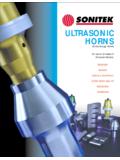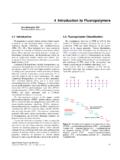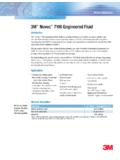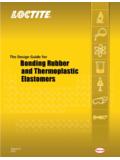Transcription of JOINT DESIGN FOR ULTRASONIC WELDING
1 W55w15W4 SLIP FITFIXTUREW4W4W5 WWTOUNGE AND GROOVE VARIATIONSTEP JOINT VARIATION45 45 Figure diagrams show timetemperature curves for a common buttjoint and more ideal JOINT incorporatingan energy director. This modified jointpermits rapid WELDING while achievingmaximum strength. The material withinthe director becomes the sealant whichis spread throughout the JOINT area asindicated a simple butt jointmodified with energy directors showingdesired proportions before weld andindicating the resultant flow of should be dimensioned to allowfor the dissipation of the material fromthe energy director throughout the jointarea as a step JOINT usedwhere a weld bead on the side would beobjectionable. This JOINT is usually muchstronger than a butt JOINT , since materialflows into the clearance necessary for aslip fit, establishing a seal that providesstrength in shear as well as tongue and groove jointusually has the capability of providinggreatest strength.
2 The need to maintainclearance on both sides of the tongue,however, makes this more difficult tomold. Draft angles can be modifiedconcurrently with good moldingpractices, but interference betweenelements must be 5. Illustrates basic JOINT variationssuitable for ULTRASONIC WELDING . Theseare suggested guidelines for typical jointproportions. Specific applications mayrequire slight modification. Practicalconsiderations suggest a minimumheight of .005 for the energy height greater than .020 isindicated, two or more directors shouldbe provided with the sum of heightsequalling the formula the interference jointused when a hermetic JOINT is needed forthe crystalline thermoplastics (nylon,acetal, polyethylene, polypropylene).Since crystalline resins (such as acetaland nylon) have a tendency of beingwatery in the motion state, the adjoiningsurfaces remain cool when the energydirector has become molten, resulting inlittle or no interaction of melted andunmelted NoteJOINT DESIGN FOR ULTRASONIC WELDW90 AFTER WELDDISTRIBUTED IN JOINTW3W12W10W3W5 WCLEARENCE FITDRAFT ANGLE 3 to 5 ACDBAFTER WELDBEFORE WELDWW3 SLIPFITFig.
3 1 Fig. 2 Fig. 3 Fig. 4 Fig. 5 Fig. 6 Note:When the interference JOINT isused, weld strength of crystalline materi-als approaches 95% of parent materialstrength, as opposed to 40-70% whenenergy director is used. The interferencejoint permits interaction between the twosurfaces during the entire melt cycle byexposing more and more surface area asthe two surface planes interfere underultrasonic and clamp fixturing should be used when theinterference JOINT is utilized as the outerwalls of the part may flex or distort if not contained by the with ULTRASONIC WELDING and inserting, ULTRASONIC staking employs the same principles of creating localized heatthrough the application of high-frequency vibrations. Many stakingapplications involve the assembly of metal and plastic staking, a hole in the metal receives a plastic staking requires the release of vibratory energy only at thesurface of the plastic stud; therefore, the contact area between hornand plastic must be kept as small as possible (Figure 3).
4 The horn is usually contoured to meet the specific requirements of the application. With the introduction of ULTRASONIC vibrations, the studmelts and reforms to create a locking head over the REQUIREMENTST here are two head-forms that will satis-fy the requirements of a majority of applications (Figure 4). The first,generally considered standard, produces a head having twice thediameter of the original stud, with the height 1/2 the stud second, referred to as a low-profile head, has a head diameter 1 1/2 times the stud diameter, with a head height 1/4 the size of thehead diameter. In addition when a conical stud can be used it is thebest choice for filled materials. When appearance is not important, aknurled profile can be an excellent ULTRASONIC plastics WELDING , staking requires thatout-of-phase vibrations be generated between the horn and plasticsurfaces.
5 Light, initial contact pressure is therefore a requirement forout-of-phase vibratory activity within the limited contact area asshown in Figure 3. It is the progressive melting of plastic undercontinuous, but light pressure, that forms the head. Adjustment ofthe flow-control valve and trigger switch may be required to reducepressure to the desired INSERTING AND STAKINGLEAD INUNDERCUTINTERFACET hreaded DEPTHINSERT LENGTHPLUS .030"Head HeightAbove PartBefore .5d2dLow PROFILESTANDARDMelt developed at this carriedto end of horn small contact Surface Configuration Final Surface Configuration Fig. 2 Fig. 1 Fig. 3 Fig. 4 INSERTING METAL INTO PLASTICFor ULTRASONIC insertion a hole is premolded in the plastic slightly smaller in diameter than the insertit is to receive.
6 Such a hole provides a certain degree of interference-fit and guides the insert intoplace. For a final interlocking assembly, the metal insert is usually knurled, undercut, or shaped toresist the loads imposed on the finished assembly as pressure is vibrations travel through the driven part until they meet the joining area between metaland plastic. At this JOINT (or interface) the energy of the ULTRASONIC vibrations is released as heat. Theintensity of heat created by the vibration between the plastic and the metal is sufficient to melt theplastic momentarily, permitting the inserts to be driven into exposure time is usually less than one second, but during this brief contact the plasticreforms itself around knurls, flutes, undercuts, or threads to encapsulate the typical assembly consisting of a knob of impact styrene and a steel insert as shown (See Figure 1).
7 If a knob of this type is used as a locking device, it must withstand torque-loading as it is tightened on a threaded rod. It must also withstand axial shear forces as pressure is broughtto bear against both plastic and metal insert REQUIREMENTS Insert/hole DESIGN will vary with each application, but a sufficient volumeof plastic must always be displaced to fill voids created by knurled and undercut areas of the slight excess of molten material can usually be tolerated while insufficient interference may resultin less than required the relationship of dimensions between a typical undercut insert and the diameter of the premolded hole. For tapered inserts, the hole should also be tapered, as shown in Figure 2. This configuration permits accurate positioning of the insert and reduces installationtime.
8 The choice of contacting the plastic or metal surface with the horn will depend upon the configuration of the part, and the ability of the assembly to accept the required vibratory alloyDenotes compatibilityDenotes compatibilityin some cases (usually blends)AcrylicAcrylic multipolymerButadiene-styrenePhenylene-o xide based resinsPolyamide-imidePolyarylatePolycarb onatePolyetherimidePolyethersulfonePolys ulfonePVC (rigid)SAN-NAS-ASAX enoy (PBT/polycarbonate alloy)AcetalCellulosicsFluoropolymersIon omerLiquid crystal polymersNylonSemi-Crystalline PolymersAmorphous PolymersPolystyrene (general purpose)Polystyrene (rubber modified)Polyethylene terephthalate - PETP olybutylene terephthalate - PBTP olyetheretherketone - PEEKP olyethylenePolymethylpentenePolyphenylen e sulfidePolypropylene ABSABS/polycarbonate alloyAcrylicAcrylic multipolymerButadiene-styrenePhenylene-o xide based resinsPolyamide-imidePolyarylatePolycarb onatePolyetherimidePolyethersulfonePolys ulfonePVC (rigid)SAN-NAS-ASAX enoy (PBT/polycarbonate alloy)AcetalCellulosicsFluoropolymersIon omerLiquid crystal polymersNylonSemi-Crystalline PolymersPolystyrene (general purpose)Polystyrene (rubber modified)
9 Polyethylene terephthalate - PETP olybutylene terephthalate - PBTP olyetheretherketone - PEEKP olyethylenePolymethylpentenePolyphenylen e sulfidePolypropylene Amorphous PolymersGeneral-purpose plasticsABS95-100+EEGEGP olystyrene unfilled95-100+EEFEES tructural foam90-100aEEFGPR ubber modified95-100 EEGEG-PGlass filled (up to 30%)95-100+EEFEESAN95-100+EEFEEE ngineering plasticsABS95-100+EEGEGABS/polycarbonate alloy (Cycoloy 800)95-100+bEEGEGABS/PVC alloy (Cycovin)95-100+EEGGFA cetal65-70cGEPGGA crylics95-100+dGEPEGA crylic multipolymer (XT-polymer)95-100 EEGEGA crylic/PVC alloy (Kydex)95-100+EEGGFASA95-100+EEGEGM odified phenylene oxide (Noryl)95-100+EEF-PGE-GNylon90-100+bEEF- PGFP henoxy90-100 GEGGG-FPolycarbonate95-100+bEEG-FEEP olyimide80-90 FGPGFP olyphenylene oxide95-100+EGF-PGG-FPolysulfone95-100+b EEFGG-FHigh-volume, low-cost applicationsButyrates90-100GG-FGPPC ellulosics90-100GG-FGPPP olyethelene90-100 EEGG-PF-PPolypropylene90-100 EEGG-PF-PStructural foam85-100 EEFGF-PVinyls40-100GG-FGF-PF-P% Weldstrength*Spot weldStaking andinsertingSwagingNearfield Farfield MaterialWeldingTABLE I CHARACTERISTICS**Code: E= Excellent, G= Good, F= Fair, P=Poor*Weld strenths are based on destructive testing100+% results indicate that parent materialof plastic part gave way while weld remained intact.
10 Near field WELDING refers to joint1/4 in. or less from area of horn contact; far field WELDING to JOINT more than 1/4 in. from contact foams weld will inhibit high energy and long ULTRASONIC exposure because of low coefficient of grades are more difficult to weld due tohigh molecular weightULTRASONIC WELDINGCHARACTERISTICS AND COMPATIBILITY OFTHERMOPLASTICSMost commonly used injection-moldedmaterials can be ultrasonically weldedwithout the use of solvents, heat oradhesives. Weldability of these materi-als depends on their melting tempera-tures, modulus of elasticity, impactresistance, coefficient of friction, andthermal conductivity. Generally, themore rigid the plastic, the easier it is toweld. Low modulus materials such aspolyethylene can often be weldedprovided the horn can be positionedclose to the JOINT staking, the opposite is usually softer the plastic, the easier it is tostake.






